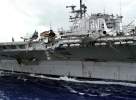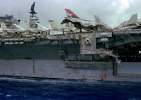 |
Search the Site with

|
USS Midway (CV 41)
- formerly CVA 41, formerly CVB 41 -- decommissioned -
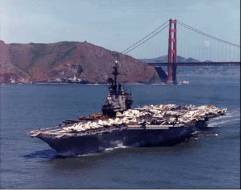 |  |  |
Named for the Battle of Midway, USS MIDWAY was the lead ship of her class, three of which were completed, with another two ships cancelled. Serving her country for 47 years, more than 200,000 American veterans served aboard her. During that time, the USS MIDWAY saw service off Vietnam, in the Persian Gulf and in a number of other conflicts and crises. After being the first aircraft carrier forward deployed for 17 years in Yokosuka, Japan, she returned to North Island Naval Air Station in San Diego for decommissioning in April of 1992. In over five decades of service, she received the Presidential Unit Citation; Navy Unit Commendation; U.S. Navy & Marine Corps Expeditionary Medal; Navy Occupation Service Medal; China Service Expeditionary Medal; and Vietnam Service Medal.
Commissioned as CVB 41, the MIDWAY was redesignated as attack aircraft carrier CVA 41 on October 1, 1952, and multi-purpose aircraft carrier CV 41 on June 30, 1975.
Today, the MIDWAY is serving as a floating museum in the city of San Diego. There are two Photo Tours of the USS MIDWAY Museum available. Click here for a Photo Tour with photos from 2007 or click here for photos from 2008 and 2010.
| General Characteristics: | Keel laid: October 27, 1943 |
| Launched: March 20, 1945 | |
| Commissioned: September 10, 1945 | |
| Decommissioned: mid-1955 | |
| Recommissioned: September 30, 1957 | |
| Decommissioned: April 11, 1992 | |
| Builder: Newport News Shipbuilding, Newport News, Va. | |
| Propulsion system: 12 boilers, four Westinghouse geared turbines | |
| Propellers: four | |
| Aircraft elevators: three | |
| Arresting gear cables: three | |
| Catapults: two | |
| Length: 997,4 feet (304 meters) | |
| Flight Deck Width: 237,9 feet (72.5 meters) | |
| Beam: 121 feet (36.9 meters) | |
| Draft: 38,1 feet (11.8 meters) | |
| Displacement: approx. 64,000 tons full load | |
| Speed: 30+ knots | |
| Planes: 1945: 80-145 planes (highest number never embarked), later: approx. 65 planes | |
| Crew: ship: approx. 2,533 Air Wing: 2,240 | |
| Armament: see down below |
Crew List:
This section contains the names of sailors who served aboard USS MIDWAY. It is no official listing but contains the names of sailors who submitted their information.
- Click here to view the list.
- Click here
to see which USS MIDWAY memorabilia are currently for sale on ebay.
USS MIDWAY Cruise Books:
- Mediterranean Cruise Book 1947-48
- Mediterranean Cruise Book 1950
- Mediterranean Cruise Book 1952
- Mediterranean Cruise Book 1952-53
- Mediterranean Cruise Book 1954
- World Cruise Book 1955
- WestPac Cruise Book 1958-59
- WestPac Cruise Book 1959-60
- WestPac Cruise Book 1961
- WestPac Cruise Book 1962
- WestPac Cruise Book 1963-64
- WestPac Cruise Book 1965
- WestPac Cruise Book 1971
- WestPac Cruise Book 1972-73
- WestPac Cruise Book 1974
- WestPac Cruise Book 1975-76
- WestPac Cruise Book 1977
- WestPac Cruise Book 1978-79
- WestPac Cruise Book 1979-80
- WestPac Cruise Book 1981-82
- WestPac Cruise Book 1982-83
- WestPac Cruise Book 1984-85
- WestPac Cruise Book 1985-87
- WestPac Cruise Book 1987-89
- WestPac Cruise Book 1989-90
- Operation Desert Storm Cruise Book 1990-91
About the different armament:
- 1945: 18 5-inch (12,7 cm) 54 caliber guns, 84 40mm guns and 28 20mm guns
- 1950: 14 5-inch (12,7 cm) 54 caliber guns and 40 3-inch (7,6 cm) 50 caliber guns
- 1957: 10 5-inch (12,7 cm) 54 caliber guns and 22 3-inch (7,6 cm) 50 caliber guns
- 1961: 10 5-inch (12,7 cm) 54 caliber guns
- 1963: 4 5-inch (12,7 cm) 54 caliber guns
- 1970: 3 5-inch (12,7 cm) 54 caliber guns
- 1985: 2 Mk-25 launchers for Sea Sparrow, 2 Phalanx CIWS Mk-15
About the V-2 missile launch aboard USS MIDWAY:
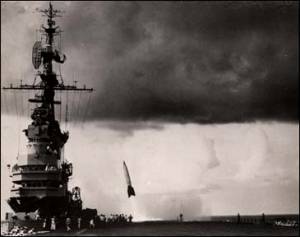 On a cloudy September day, two years after the end of World War II, a captured German V-2 rocket was successfully test fired from the USS MIDWAY. This was a historic first in the annals of naval warfare.
On a cloudy September day, two years after the end of World War II, a captured German V-2 rocket was successfully test fired from the USS MIDWAY. This was a historic first in the annals of naval warfare.
Naval records indicate the test took place several hundred miles off the East Coast of the United States with the country's top naval and civilian rocketry experts in attendance. The goal of the test? To determine if modern rockets could be fired from naval platforms and perform as intended. At that time, there was some question as to whether major modifications might be necessary for shipboard launches of missiles.
The V-2 successfully lifted off the USS MIDWAY and was exploded about six miles away, just a few minutes after launch.
Although the test took place on September 6, 1947, the results and photography were not released to the public until the next month, on October 13, 1947. Rear Admiral D.V. Gallery, Assistant Chief of Naval Operations for Guided Missiles, declared the test a success. The MIDWAY missile test is now considered to have been the dawn of naval missile warfare.
Accidents aboard USS MIDWAY:
Notes of Interest:
- During three tours of duty in the Tonkin Gulf, aircraft from the USS MIDWAY downed the first three and last MiG in the Vietnam conflict.
- USS MIDWAY was the first carrier to be "forward deployed" in a foreign country, sailing for 17 years out of Yokosuka, Japan.
- When operating at sea, USS MIDWAY was refueled every three days. She burned approximately 100,000 gallons a day.
- When she was first built, USS MIDWAY's bow was open to the sea. It was enclosed in 1957 as part of a major overhaul.
- The MIDWAY was named for the Battle of Midway, considered by many to be the turning point in the Pacific War. The movie by the same name was actually shot aboard the USS LEXINGTON (CV 16) and USS CONSTELLATION (CV 64).
USS MIDWAY Patch Gallery:
 | 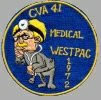 |  | 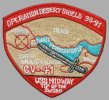 | 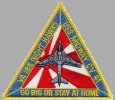 |
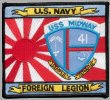 |  | Click here to view more USS MIDWAY Patches. | ||
USS MIDWAY's Commanding Officers:
| Period | Name |
|---|---|
| September 10, 1945 - January 12, 1946 | Captain Joseph F. Bolger, USN |
| January 12, 1946 - July 18, 1946 | Captain Herbert S. Duckworth, USN |
| July 18, 1946 - August 11, 1947 | Captain John P. Whitney, USN |
| August 11, 1947 - April 22, 1948 | Captain Albert K. Morehouse, USN |
| April 22, 1948 - May 28, 1948 | Commander Forsyth Massey, USN |
| May 28, 1948 - September 7, 1948 | Commander Raymond N. Sharp, USN |
| September 7, 1948 - August 8, 1949 | Captain Marcel E. A. Gouin, USN |
| August 8, 1949 - July 1, 1950 | Captain Wallace M. Beakley, USN |
| July 1, 1950 - March 8, 1951 | Captain Frederick N. Kivette, USN |
| March 8, 1951 - April 2, 1952 | Captain Kenneth Craig, USN |
| April 2, 1952 - April 4, 1953 | Captain Frank O'Beirne, USN |
| April 4, 1953 - January 19, 1954 | Captain Clifford S. Cooper, USN |
| January 19, 1954 - October 1, 1954 | Captain William H. Ashford, Jr., USN |
| October 1, 1954 - September 7, 1955 | Captain Reynold D. Hogle, USN |
| September 7, 1955 - October 14, 1955 | Commander Richard S. Rogers, USN |
| September 30, 1957 - June 2, 1958 | Captain Francis E. Neussle, USN |
| June 2, 1958 - May 29, 1959 | Captain John T. Blackburn, USN |
| May 29, 1959 - June 15, 1960 | Captain James H. Mini, USN |
| June 15, 1960 - April 22, 1961 | Captain Ralph W. Cousins, USN |
| April 22, 1961 - April 21, 1962 | Captain Robert G. Dose, USN |
| April 21, 1962 - January 25, 1963 | Captain Roy M. Isaman, USN |
| January 25, 1963 - January 25, 1964 | Captain Leroy E. Harris, USN |
| January 25, 1964 - December 19, 1964 | Captain Whitney Wright, USN |
| December 19, 1964 - February 15, 1966 | Captain James M. O'Brien, USN |
| January 31, 1970 - July 10, 1971 | Captain Eugene J. Carroll, Jr., USN |
| July 10, 1971 - July 31, 1972 | Captain William L. Harris, Jr., USN |
| July 31, 1972 - September 7, 1973 | Captain S. R. Foley, Jr., USN |
| September 7, 1973 - March 26, 1975 | Captain R. J. Schulte, USN |
| March 26, 1975 - October 20, 1976 | Captain Larry C. Chambers, USN |
| October 20, 1976 - February 27, 1978 | Captain D. L. Felt, USN |
| February 27, 1978 - September 7, 1979 | Captain Thomas F. Brown III, USN |
| September 7, 1979 - February 17, 1981 | Captain E. Inman Carmichael, USN |
| February 17, 1981 - August 21, 1982 | Captain Robert S. Owens, USN |
| August 21, 1982 - January 31, 1984 | Captain Charles R. McGrail, USN |
| January 31, 1984 - June 22, 1985 | Captain Harry P. Kober, USN |
| June 22, 1985 - April 10, 1987 | Captain Riley D. Mixson, USN |
| April 10, 1987 - February 25, 1989 | Captain Richard A. Wilson, USN |
| February 25, 1989 - June 12, 1990 | Captain Bernard J. Smith, USN |
| June 12, 1990 - June 13, 1991 | Captain Arthur K. Cebrowski, USN |
| June 13, 1991 - April 11, 1992 | Captain Larry L. Ernst, USN |
History of USS MIDWAY:
USS MIDWAY was laid down 27 October 1943 by Newport News Shipbuilding Co., Newport News, Va.; launched 20 March 1945; sponsored by, Mrs. Bradford William Ripley, Jr.; and commissioned 10 September 1945, Capt. Joseph F. Bolger in command.
After shakedown in the Caribbean, MIDWAY joined in the Atlantic Fleet training schedule, with Norfolk her homeport. From 20 February 1946 she was flagship for CarDiv 1. In March, she tested equipment and techniques for cold weather operations in the North Atlantic. East coast and Caribbean training was highlighted by Operation Sandy, in which in September 1947, she test fired a captured German V-2 rocket from her flight deck, first such launching from a moving platform.
On 29 October 1947, MIDWAY sailed for the first of her annual deployments with the 6th Fleet, mighty peacekeeping force in the Mediterranean. A powerful extension of sea/air power, MIDWAY trained between deployments and received alterations necessary to accommodate heavier aircraft as they were developed.
From 26 to 29 May 1952, the feasibility of the angled deck concept was demontrated in tests conducted on a simulated angled deck aboard MIDWAY by Naval Air Test Center pilots and Atlantic Fleet pilots in both jet and prop aircraft. MIDWAY also participated in North Sea maneuvers with NATO forces, and on 1 October was redesignated CVA 41.
MIDWAY cleared Norfolk 27 December 1954 for a world cruise, sailing via the Cape of Good Hope for Taiwan, where she joined the 7th Fleet on 6 February 1955 for operations in the western Pacific. This was the first operation of ships of her class in the western Pacific. MIDWAY remained with the 7th Fleet until 28 June 1955 when she sailed for overhaul at Puget Sound Naval Shipyard. Here, she was out of commission until 30 September 1957, while she was modernized and such new innovations as an enclosed bow and an angled flight deck were installed.
Homeported at Alameda, MIDWAY began annual deployments with the 7th Fleet in 1958. On 8 December 1958, the first firing of a Sparrow III air-to-air missile by a squadron deployed outside the U.S. was conducted by VF-64, based aboard MIDWAY. The carrier was also on duty in the South China Sea during the Laotian crisis of spring 1961. During her 1962 deployment, her aircraft tested the air defense systems of Japan, Korea, Okinawa, the Philippines, and Taiwan.
The carrier continued its role as a research and development platform. On 13 June 1963, Lt. Cmdr. Randall K. Billins and Lt. Cmdr. Robert S. Chew Jr., of Naval Air Test Center Patuxent River, Md., piloting an F-4A Phantom II and an F-8D Crusader respectively, made the first fully automatic carrier landings with production equipment on board MIDWAY off the California coast. The landings, made "hands off" with both flight controls and throttles ooperated automatically by signals from the ship, highlighted almost 10 years of research and development and followed by almost six years the first such carrier landings made with test equipment.
When MIDWAY again sailed for the Far East 6 March 1965, her aircraft were prepared for combat operations, and from mid-April flew strikes against military and logistics installations in North and South Vietnam. On 17 June 1965, while escorting a strike on the barracks at Gen Phu, North Vietnam, Cmdr. Louis C. Page and Lt. Jack E.D. Batson, flying F-4B Phantoms of VF-21, deployed aboard MIDWAY, intercepted four MiG-17s and each shot down one, scoring the first U.S. victories over MiGs in Vietnam.
Returning to Alameda 23 November 1965, she entered San Francisco Bay Naval Shipyard 11 February 1966 for extensive modernization, for which she was placed in Reserve, in commission special, 15 February 1966. She was recommissioned 31 January 1970 following the four-year conversion-modernization at the shipyard.
MIDWAY returned to Vietnam and on 18 May 1971, after relieving USS HANCOCK (CVA 19) on Yankee Station, began single carrier operations which continued until the end of the month. She departed Yankee Station on 5 June, and completed her final line period on 31 October. She returned to her homeport on 6 November.
MIDWAY, with embarked Carrier Air Wing Five (CVW 5), again departed Alameda for operations off Vietnam on 10 April 1972. On 11 May, aircraft from MIDWAY along with those from USS CORAL SEA (CV 43), USS KITTY HAWK (CV 63), and USS CONSTELLATION (CV 64) continued laying minefield in ports of signicance to the North Vietnamese - Thanh Hoa, Dong Hoi, Vinh, Hon Gai, Quang Khe and Cam Pha as well as other approaches to Haiphong. Ships that were in port in Haiphong had been advised that the mining would take place and that the mines would be armed 72 hours later. MIDWAY continued Vietnam operations throughout the summer of 1972.
On 7 August 1972, an HC-7 Det 110 helicopter, flying from MIDWAY, and aided by planes from the carrier and USS SARATOGA (CV 60), conducted a search and rescue mission for a downed aviator in North Vietnam. The pilot of an A-7 aircraft from SARATOGA had been downed by a surface-to-air missile about 20 miles inland, northwest of Vinh, on 6 August. The HC-7 helo flew over mountainous terran to rescue the pilot. The rescue helicopter used its search light to assist in locating the downed aviator and, despite receiving heavy ground fire, was successful in retrieving him and returning to an LPD off the coast. This was the deepest penetration of a rescue helicopter into North Vietnam since 1968. HC-7 Det 110 continued its rescue missions and by the end of 1972 had successfully accomplished 48 rescues, 35 of which were under combat conditions.
On 5 October 1973, MIDWAY, with CVW 5, put into Yokosuka, Japan, marking the first forward-deployment of a complete carrier task group in a Japanese port as the result of an accord arrived at on 31 August 1972 between the U.S. and Japan. In addition to the morale factor of dependents housed along with the crew in a foreign port, the move had strategic significance because it facilitated continuous positioning of three carriers in the Far East at a time when the economic situation demanded the reduction of carriers in the fleet.
MIDWAY, USS CORAL SEA, USS HANCOCK, USS ENTERPRISE (CVAN 65) and USS OKINAWA (LPH 3) responded 19 April 1975 to the waters off South Vietnam when North Vietnam overran two-thirds of South Vietnam. Ten days later, Operation Frequent Wind was carried out by U.S. Seventh Fleet forces. Hundreds of U.S. personnel and Vietnamese were evacuated to waiting ships after the fall of Saigon to the North Vietnamese. One South Vietnamese pilot landed a small aircraft aboard Midway, bringing himself and his family to safety.
On 21 August 1976, a Navy task force headed by MIDWAY made a show of force off the coast of Korea in response to an unprovoked attack on two U.S. Army officers who were killed by North Korean guards on 18 August. MIDWAY's response was in support of a U.S. demonstration of military concern vis-à-vis North Korea.
MIDWAY relieved USS CONSTELLATION as the Indian Ocean contingency carrier on 16 April 1979. MIDWAY and her escort ships continued a significant American naval presence in the oil-producing region of the Arabian Sea and Persian Gulf. On 18 November, she arrived in the northern part of the Arabian Sea in connection with the continuing hostage crisis in Iran. Militant followers of the Ayatollah Khomeini, who had come to power following the overthrow of the Shah, seized the U.S. Embassy in Tehran on 4 November and held 63 U.S. citizens hostage. MIDWAY was joined 21 November by USS KITTY HAWK, and both carriers, along with their escort ships, were joined by USS NIMITZ (CVN 68) and her escorts on 22 January 1980. MIDWAY was relieved by USS CORAL SEA on 5 February.
Following a period in Yokosuka, Midway was again on duty, this time relieving USS CORAL SEA 30 May 1980 on standby south of the Cheju-Do Islands in the Sea of Japan following the potential of civil unrest in the Republic of Korea. On 17 August, MIDWAY was relieved by USS CONSTELLATION to begin another Indian Oean deployment and to complement the USS DWIGHT D. EISENHOWER (CVN 69) task group still on contingency duty in the Arabian Sea. MIDWAY spent a total of 118 days in the Indian Ocean during 1980.
On 16 March 1981, an A-6 Intruder from VA-115 aboard MIDWAY sighted a downed civilian helicopter in the South China Sea. MIDWAY immediately dispatched HC-1 Det 2 helicopters to the scene. All 17 people aboard the downed helicopter were rescued and brought aboard the carrier. The chartered civilian helicopter was also plucked out of the water and lifted to MIDWAY's flight deck.
MIDWAY continued serving in the western Pacific thoughout the 1980s. On 25 March 1986, the final carrier launching of a Navy fleet F-4S Phantom II took place off MIDWAY during flight operations in the East China Sea. The aircraft was manned by pilot Lt. Alan S. Cosgrove and radar intercept officer Lt. Greg Blankenship of VF-151. Phantoms were being replaced by the new F/A-18 Hornets.
On 2 August 1990, Iraq invaded its neighbor Kuwait, and U.S. forces moved into Saudi Arabia as part of Operation Desert Shield to protect that country against invasion by Iraq. On 1 November 1990, MIDWAY was again on station in the North Arabian Sea, relieving USS INDEPENDENCE (CV 62). On 15 November, she participated in Operation Imminent Thunder, an eight-day combined amphibious landing exercise in northeastern Saudi Arabia which involved about 1,000 U.S. Marines, 16 warships, and more than 1,100 aircraft. Meanwhile, the United Nations set an ultimatum deadline of 15 January 1991 for Iraq to withdraw from Kuwait.
President George H.W. Bush addressed the nation on 16 January 1991 at 9 p.m. EST and announced that the libration of Kuwait from Iraq, Operation Desert Storm, had begun. The Navy launched 228 sorties from MIDWAY and USS RANGER (CV 61) in the Persian Gulf, from USS THEODORE ROOSEVELT (CVN 71) enroute to the Gulf, and from USS JOHN F. KENNEDY (CV 67), USS SARATOGA, and USS AMERICA (CV 66) in the Red Sea. In addition, the Navy launched more than 100 Tomahawk missiles from nine ships in the Mediterranean Sea, the Red Sea, and the Persian Gulf. At 9 p.m. EST on 27 February, President Bush declared Kuwait had been liberated and Operation Desert Storm would end at midnight. MIDWAY departed the Persian Gulf 11 March 1991 and returned to Yokosuka.
In August 1991, MIDWAY departed Yokosuka and returned to Pearl Harbor. Here, she turned over with USS INDEPENDENCE which was replacing MIDWAY as the forward-deployed carrier in Yokosuka. MIDWAY then sailed to San Diego where she was decommissioned at North Island Naval Air Station on 11 April 1992. She was stricken from the Navy List on 17 March 1997 and spend the following years at the Navy Inactive Ship Maintenance Facility, Bremerton, Wash. In 2005, she was towed to San Diego, where she is now serving as a floating museum.
About the Ship’s Name, about the Battle of Midway:
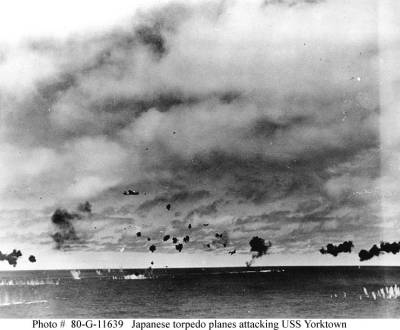 A strong Japanese thrust in the central Pacific to occupy Midway Island was led by a four-carrier Mobile Force, supported by heavy units of the Japanese First Fleet, and covered by a diversionary carrier raid on Dutch Harbor in the Aleutian Islands of Alaska. The Japanese attack on Midway was met by a greatly outnumbered U.S. carrier force composed of task Force 17 (Rear Adm. Fletcher) with USS YORKTOWN (CV 5) and Task Force 16 (Rear Adm. Raymond A. Spruance) with USS HORNET (CV 8) and USS ENTERPRISE (CV 6).
A strong Japanese thrust in the central Pacific to occupy Midway Island was led by a four-carrier Mobile Force, supported by heavy units of the Japanese First Fleet, and covered by a diversionary carrier raid on Dutch Harbor in the Aleutian Islands of Alaska. The Japanese attack on Midway was met by a greatly outnumbered U.S. carrier force composed of task Force 17 (Rear Adm. Fletcher) with USS YORKTOWN (CV 5) and Task Force 16 (Rear Adm. Raymond A. Spruance) with USS HORNET (CV 8) and USS ENTERPRISE (CV 6).
Early in the morning of 4 June, the Japanese sent their torpedo, horizontal and dive bombers against targets on Midway. HORNET, YORKTOWN, and ENTERPRISE launched strikes as the Japanese carriers struck their planes below to prepare for a second strike on Midway. HORNET‘s dive bombers missed contact, but 15 planes comprising her Torpedo Squadron 8 found the enemy and pressed home their attacks. They were met by overwhelming fighter opposition about 8 miles from three enemy carriers and followed all the way in to be shot down one by one.
Ens. George H. Gay, USNR, the only surviving pilot, reached the surface as his plane sunk. He hid under a rubber seat cushion to avoid strafing and witness the greatest carrier battle in history. Of 41 torpedo planes launched by the American carriers, only six returned. Their sacrifices drew enemy fighters away from dive bombers of ENTERPRISE and YORKTOWN which sank three of the four Japanese carriers (AKAGI, KAGA, and SORYU) with an assist from submarine USS NAUTILUS (SS 168). The fourth Japanese carrier, HIRYU, was sunk the following day.
On June 6, 1942, USS YORKTOWN (CV 5) was attacked by Japanese "Vals" and "Zeros". Intense antiaircraft fire greeted these planes as they approached YORKTOWN but three "Val" divebombers scored hits, each sending a bomb into the carrier. One bomb blew a 10-sq. ft. hole in the flight deck and started fires. The second pierced the flight deck and exploded in the lower part of the funnel. The third ripped through the number one elevator and exploded on the fourth deck. Within an hour, the crew had the fires sufficiently contained and were refueling aircraft.
The fueling had just begun with the ship's radar picked up more attackers. In minutes, Japanese torpedo planes were attacking. Although the ship was maneuvering radically, two torpedoes tore into her port side and she went dead in the water, listing to port. Without power, the list worsened and all hands were order to abandon ship.
When the ship stubbornly remained afloat, a salvage party was organized to save YORKTOWN. Power was supplied by USS HAMMANN (DD 412).
Just as it looked like the YORKTOWN could be saved, a Japanese submarine fired four torpedoes at the carrier and her assisting destroyer. One torpedo hit HAMMANN directly amidship and broke her back. She jackknifed and went down rapidly. Two torpedoes hit the carrier, and moments after HAMMANN‘s stern slid beneath the waves, her depth charges exploded, killing men in the water and further damaging YORKTOWN. Although the carrier stayed afloat throughout the night of June 6, men on the ships nearby noted her port list increasing rapidly. At 0701, the valiant flattop rolled over on her port side and sank in 3,000 fathoms of water, her battle flags flying.
Midway was one of the decisive battles of history that had far reaching and enduring results on the Pacific War. Midway was saved as an important base for operations into the western Pacific. Likewise saved was Hawaii. Of greatest importance was the crippling of Japan's carrier strength, a severe blow from which she never fully recovered. The four large aircraft carriers sent to the bottom of the sea carried with them 258 planes along with a high percentage of Japan's most highly trained and battle-experienced carrier pilots. Midway was the turning point of the war in the Pacific.
USS MIDWAY Image Gallery:
 | 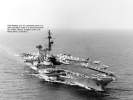 | 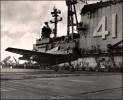 |  | 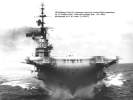 |
 | 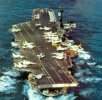 | 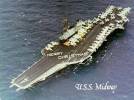 | 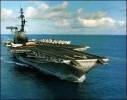 | 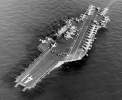 |
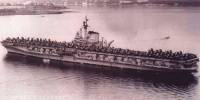 | 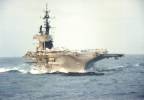 | 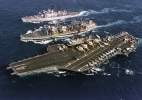 | ||
The photos below show the MIDWAY being towed to San Diego on April 1, 2005, for future use as a floating museum.
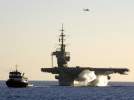 |  | 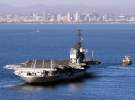 |  |
The photos below were taken by Katja Bartz on September 12, 2007, during a visit to the USS MIDWAY museum in San Diego, Calif.
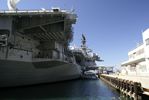 | 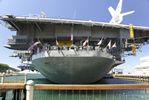 | 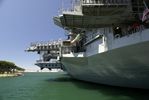 | 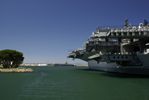 | 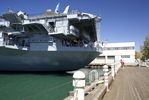 |
 |  | 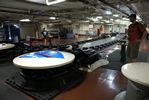 | 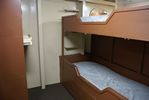 | 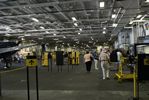 |
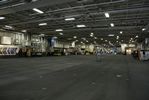 |  | 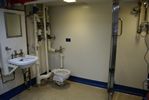 | Click here for more Photos. | |
The photos below were taken by me during a visit to the USS MIDWAY museum in San Diego, Calif., on March 23, 2010.
 | 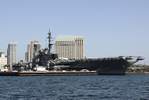 | 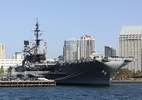 | 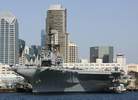 | 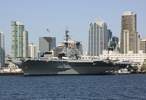 |
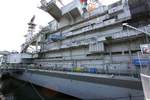 | 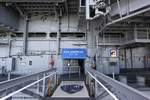 | 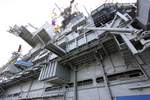 | 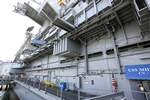 | 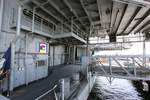 |
 | 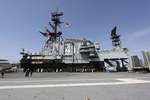 |  | Click here for more Photos. | |
The photos below were taken by Sebastian Thoma and show the MIDWAY Museum at San Diego, Calif., on December 20, 2016.
 | 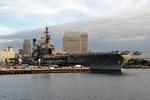 | 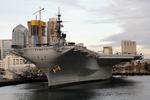 |  | 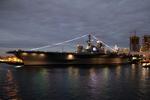 |
The photos below were taken by Sebastian Thoma and show the MIDWAY Museum at San Diego, Calif., on November 28 and November 29 (aerial photos), 2021.
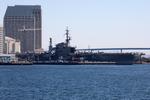 | 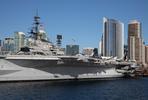 | 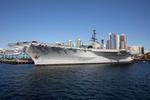 | 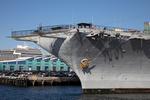 | 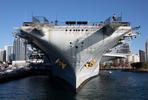 |
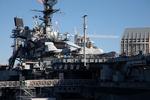 | 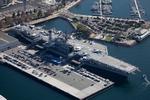 |  | 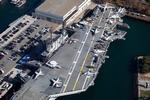 |  |
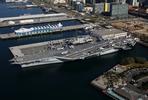 | 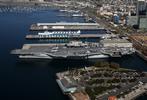 |
 Back to Carriers list.
Back to Carriers list.  Back to ships list.
Back to ships list.  Back to selection page.
Back to selection page.  Back to 1st page.
Back to 1st page.

